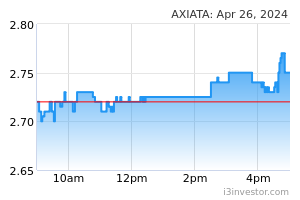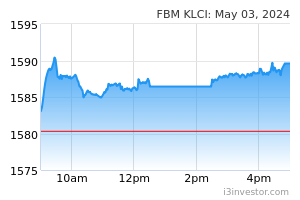Daily Brief - 12 Sept 2024
sectoranalyst
Publish date: Thu, 12 Sep 2024, 09:42 AM
Range Bound Pending US Inflation Data and Rate Cut
The local market fell into profit-taking correction mode on Wednesday, led by oil & gas, technology and plantation heavyweights, with worries over slower growth in the US and China dampening investor sentiment. The FBM KLCI shed 20.55 points, or 1.24 percent, to settle at 1,639.80, off an early high of 1,654.38 and low of 1,638.90, as losers trashed gainers 825 to 283 on moderate turnover of 2.96bn shares worth RM3.34bn.
Supports at 1,633/1,620; Key Resistance at 1,670/1,684
Blue chips are likely to stay range bound pending the outcome of the closely watched US inflation data and interest rate cut, and as foreign interest on key banking and utility stocks cap downside. Immediate index support remains at the recent correction low of 1,633, with 1,620 and 1,600 acting as stronger supports. Immediate resistance is revised lower to 1,670, with the recent high of 1,684, then 1,695, the Dec 2020 high, as tougher resistance levels.
Bargain Axiata & CelcomDigi
Axiata will need to overcome the 50%FR (RM2.60) decisively to extend further recovery towards the 61.8%FR (RM2.70) and 76.4%FR (RM2.84) ahead, while downside is cushioned by the lower Bollinger band (RM2.34). CelcomDigi need strong breakout momentum above the 61.8%FR (RM3.84) to sustain further upside momentum towards the 76.4%FR (RM4.05) and 30/5/23 high (RM4.37) going forward, with the lower Bollinger band (RM3.44) capping downside risk.
Asian Markets Dip as Traders Eye U.S. Inflation Data
Stocks in Asia slipped on Wednesday as traders gear up for U.S. inflation data this week and digested economic data from the region. Traders remained cautious and looked ahead to the release of closely watched key US inflation data later in the week that could impact the outlook for rates, including the pace of rate cuts. The Fed is almost universally expected to begin lowering interest rates next week, but there is some debate about if the rate cut will be 25 or 50 basis points. Traders in Asia also parsed economic data from the region. South Korea reported that unemployment fell to 2.4% in August, the lowest level since 1999, when the data series commenced, according to Statistics Korea.
Separately, Japan’s Tankan survey showed that business confidence in big manufacturers dipped to plus 4 in September, a seven-month low, from plus 10 in August. The Nikkei 225 tumbled 1.49% to finish at 35,619.77 for its eighth straight day of losses. The broad-based Topix dropped 1.8% to close at 2,530.67. South Korea’s Kospi slipped 0.4% to 2,513.37 and Australia’s S&P/ASX 200 ended 0.3% lower to close at 7,989.9. In China, Shanghai Composite index also fell 0.82% to 2,721.80, while Hong Kong’s Hang Seng index slipped 0.73% to 17,108.71.
Tech Boost Sends Wall Street Higher
Wall Street’s major indexes reversed early losses to close higher overnight, buoyed by strength in Nvidia and other mega-caps tech, while traders digested an inflation report that showed consumer price increases ticked lower during August. The Dow Jones Industrial Average gained 0.31% to close at 40,861.71. The S&P 500 rose 1.07%, ending at 5,554.13, while the Nasdaq Composite jumped 2.17% to end at 17,395.53. All three indexes staged
intraday comebacks that erased earlier losses. Information technology was the bestperforming sector in the S&P 500 index, leading the broad U.S. stock benchmark into the green as traders picked up shares of mega-cap tech and semiconductor names in afternoon trading.
Stocks initially tumbled after the core reading on the consumer price index showed core inflation, which excludes food and energy costs, unexpectedly picked up in August, even as the annual rate of headline inflation eased to a slower-than-expected 2.5%. This dampened investor hopes for a half-point rate cut from the Federal Reserve. Nvidia jumped 8% and AMD added more than 4%. The VanEck Semiconductor ETF climbed about 5%. Bank stocks, including JPMorgan Chase and Goldman Sachs, also rebounded from earlier lows and ended the session with marginal gains.
Source: TA Research - 12 Sept 2024
Related Stocks
Market Buzz
2025-01-10
AXIATA2025-01-10
AXIATA2025-01-10
AXIATA2025-01-10
AXIATA2025-01-10
AXIATA2025-01-10
CDB2025-01-10
CDB2025-01-10
CDB2025-01-10
CDB2025-01-09
CDB2025-01-09
CDB2025-01-08
CDB2025-01-08
CDB2025-01-08
CDB2025-01-07
CDB2025-01-07
CDB2025-01-07
CDB2025-01-06
AXIATA2025-01-06
AXIATA2025-01-06
AXIATA2025-01-03
AXIATA2025-01-03
AXIATA2025-01-03
AXIATA2025-01-03
AXIATA2025-01-03
CDB2025-01-02
AXIATA2025-01-02
AXIATA2025-01-02
AXIATA2025-01-02
AXIATA2024-12-31
AXIATA2024-12-31
AXIATA2024-12-31
AXIATA2024-12-31
CDBMore articles on TA Sector Research
Created by sectoranalyst | Jan 09, 2025
























